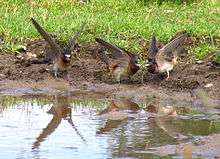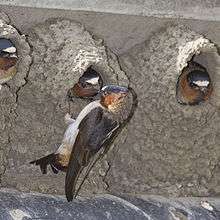American cliff swallow
| American cliff swallow | |
|---|---|
 | |
| Scientific classification | |
| Kingdom: | Animalia |
| Phylum: | Chordata |
| Class: | Aves |
| Order: | Passeriformes |
| Family: | Hirundinidae |
| Genus: | Petrochelidon |
| Species: | P. pyrrhonota |
| Binomial name | |
| Petrochelidon pyrrhonota Vieillot, 1817 | |
| Synonyms | |
|
Petrochelidon lunifrons | |
The American cliff swallow (Petrochelidon pyrrhonota) is a member of the passerine bird family Hirundinidae — the swallows and martins.The scientific name is derived from Ancient Greek. Petrochelidon is from petros, "rock", and khelidon, "swallow", and pyrrhonota from purrhos, "flame-coloured", and -notos "-backed".[2]
It breeds in North America and is migratory, wintering in western South America from Venezuela southwards to northeast Argentina. This species is a very rare vagrant to western Europe.
Description

This bird averages 13 cm (5.1 in) long with a tiny bill. The adult cliff swallow has an iridescent blue back and crown, brown wings and tail, and buff rump. The nape and forehead are white. The underparts are white except for a red face. The tail is square-ended.
Young birds are essentially brown above and whitish below, except for the buff rump and dark face. The only confusion species is the closely related cave swallow, which is richer in colour and has a cinnamon rump and forehead.
| Standard Measurements[3][4] | |
|---|---|
| length | 5–6 in (130–150 mm) |
| weight | 21 g (0.74 oz) |
| wingspan | 13.5 in (340 mm) |
| wing | 105.5–111.5 mm (4.15–4.39 in) |
| tail | 47–51 mm (1.9–2.0 in) |
| culmen | 6.4–7.3 mm (0.25–0.29 in) |
| tarsus | 12–13 mm (0.47–0.51 in) |
Like all swallows and martins, cliff swallows subsist primarily on a diet of insects which are caught in flight.
Nesting



American cliff swallows nest in colonies ranging from a few breeding pairs to thousands of birds, depending on the area and year. The number of breeding pairs in an area per year generally increases with temperature, though larger colonies are more likely to suffer from parasites and intraspecific competition.[5]
They build conical mud nests and lay three to six eggs. The natural nest sites are on cliffs, preferably beneath overhangs, but as with the Eurasian house martin, man-made structures are now the principal locations for breeding. Female American cliff swallows are known to lay eggs in and move previously laid eggs into the nests of other birds within the colony.
This species has always been plentiful in the west of North America, where there are many natural sites, but the abundance in the east has varied.
European settlement provided many new nest sites on buildings, but the population declined in the late nineteenth and early twentieth centuries as the supply of unpainted barns declined. There has been a subsequent revival as dams and bridges have provided suitable sites.
California nesting
These are the famous swallows whose return from Villa Ventana, Argentina every year to the Mission San Juan Capistrano in California on (or around) March 19 is celebrated with a festival. In recent years, the swallows have failed to return to the mission.[6]
The "Capistrano swallows" are now nesting in the Chino Hills of Southern California, north of San Juan Capistrano. Thousands of the small birds, up from "wintering" in Argentina, have built their mud nests in the eaves of the Vellano Country Club, with community buildings situated around a golf course in the Chino Hills.[7]
References
- ↑ BirdLife International (2012). "Petrochelidon pyrrhonota". IUCN Red List of Threatened Species. Version 2013.2. International Union for Conservation of Nature. Retrieved 26 November 2013.
- ↑ Jobling, James A (2010). The Helm Dictionary of Scientific Bird Names. London: Christopher Helm. pp. 300, 327. ISBN 978-1-4081-2501-4.
- ↑ Godfrey, W. Earl (1966). The Birds of Canada. Ottawa: National Museum of Canada. p. 269.
- ↑ Sibley, David Allen (2000). The Sibley Guide to Birds. New York: Knopf. p. 368. ISBN 0-679-45122-6.
- ↑ Brown, Charles R.; Brown, Mary Bomberger; Roche, Erin A. (2013-11-01). "Spatial and temporal unpredictability of colony size in Cliff Swallows across 30 years". Ecological Monographs. 83 (4): 511–530. doi:10.1890/12-2001.1. ISSN 1557-7015.
- ↑ Esquivel, Paloma (25 March 2009). "Another year without swallows. Festival goes on without birds at historic mission". The Boston Globe. Retrieved 10 August 2009.
- ↑ Gowen, Samantha (6 June 2010). "Swallows bypass O.C., alight in Chino Hills". Orange County Register. Retrieved 14 November 2013.
Books
- Turner, Angela K.; Rose, Chris (1989). A Handbook to the Swallows and Martins of the World. Helm Identification Guides. Christopher Helm Publishers Ltd. ISBN 0-7470-3202-5.
External links
| Wikisource has the text of the 1920 Encyclopedia Americana article Cliff Swallow. |
| Wikimedia Commons has media related to Petrochelidon pyrrhonota. |
| Wikispecies has information related to: Petrochelidon pyrrhonota |
- "Cliff swallow media". Internet Bird Collection.
- Cliff swallow - Petrochelidon pyrrhonota - USGS Patuxent Bird Identification InfoCenter
- Cliff swallow Species Account - Cornell Lab of Ornithology
- Cliff swallow photo gallery at VIREO (Drexel University)
- Interactive range map of Petrochelidon pyrrhonota at IUCN Red List maps
